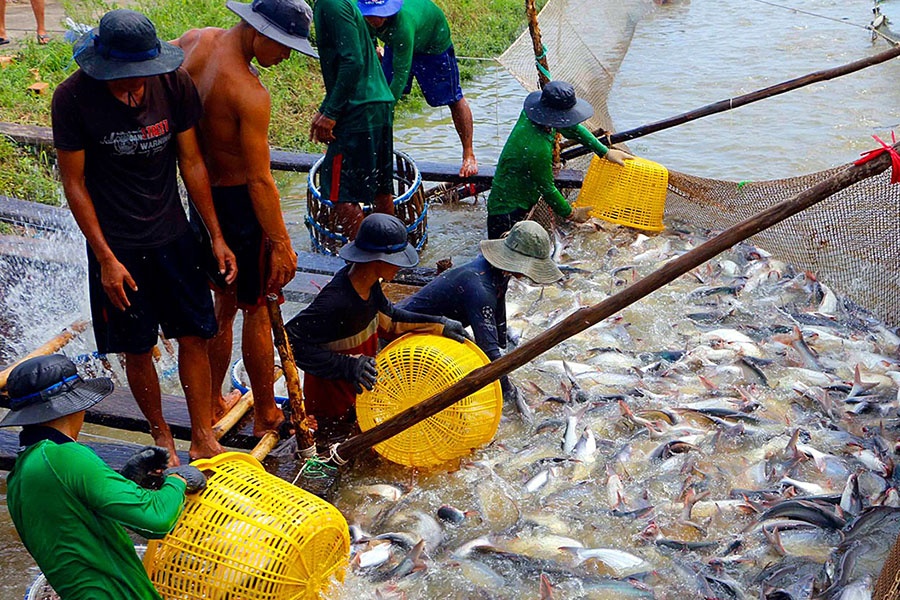Stress is a common phenomenon in aquaculture. When stressed, fish’s resistance will be reduced, susceptible to disease. Therefore, farmers need to learn and understand the causes as well as actively prevent to minimize damage.

Impact:
Stress is the main cause of fish slime loss. Mucus (the slime layer) is the first physical barrier that inhibits the invasion of pathogens from the environment into the fish. It is also a chemical barrier, containing enzymes and antibodies that can kill invading pathogens. Mucus also lubricates fish, facilitates their movement through the water, and is important for the regulation of osmotic pressure. Stress causes a silent harm to fish, and it causes fish to gradually become metabolically disturbed, leading to mineral loss and reduced nutrient absorption. Since then, the fish is slow to grow and is susceptible to diseases and if there is no timely remedy, it will lead to a decrease in yield and harvested output.
Some causes lead to stress in fish such as: Changes in weather, climate: prolonged hot weather, cloudy sky, rainy days…; sudden change of food; polyculture; transportation, captive breeding: the process of transporting breeders…; improperly stocking fish and releasing at the wrong time; too thick rearing density makes the living environment in the pond not secure; using antibiotics or handling chemicals at the wrong dose affects the water environment; poor water quality: lack of oxygen, high pH, toxic gases H2S, NO2, NH3 exceeding threshold, suspended solids, high metal content…; Fish is sick due to bacterial, viral infection…
Signs:
When stressed, the first sign that can be noticed is that the fish gradually separates from the herd and swims separately to the other area. The fish does not eat or eats less than usual. Some fish at the base of the fins will appear congested, the fish will stop eating and react more slowly than usual.
There will be congestion at the base of the fins of some fish, the fish will stop eating and react more slowly than usual.
Treatment:
After detecting signs that fish are stressed, set up a new water change for the pond. Use aeration measures to increase the oxygen content of the pond. Fully supplement Vitamin C by mixing for fish to eat or splashing in water. At the same time, using probiotics to treat water, creating a clean environment for fish.
Prevention:
Good management practices are the most effective way to prevent stress. Therefore, at the stage of pond preparation, it is necessary to clean the pond thoroughly before stocking fish, apply lime CaCO3 or Ca(OH)2, dry the pond to kill pathogens. The fish bought must know the origin and not be damaged. infected with pathogens. Newly caught fish must be isolated and quarantined. Choose healthy fingerlings.
Well control the fish transport process because during transportation, fish are always stressed due to the long distance from the nursery pond to the meat pond and at the same time the water environment is not good, which affects the health of the fish.
According to the results of a study, pangasius fingerlings are always stressed in the transport environment, especially at high density for a long time. Therefore, it is recommended to transport fish at a low density of 3,000 fish/m3 with a time longer than 2 hours, if transported for less than 2 hours, it can be transported at a high density (Do Thi Thanh Huong et al., 2014). Before stocking, bathe fish with 3% salt to disinfect wounds caused by transportation.
Feed the fish just enough, avoid excess food which can contaminate the water. Food ensures quantity and quality in the rations. Add vitamins mixed into food to prevent stress when changing weather, climate, hot weather, changing seasons…
Prevent wild birds and raptors from harming fish. Use separate tools for different ponds. Do not use with other fish from other ponds that may carry disease. In summer, it is necessary to cover the fishpond to limit direct sunlight on the lake.
Treat the fish farming environment regularly with lime powder depending on the pH of the pond water. If pH<7, apply 2 kg lime/100 m3 of water, pH 7 – 8.5 apply 1 kg lime/100 m3, periodically use 2-4 times/month. Dilute lime water and sprinkle it evenly in the pond to kill pathogens.
Mix antibiotics to feed the fish at the change of seasons or before transporting the fish. Using Sulfamerazine dose 220 mg/kg fish/day or Oxytetracycline, dose 75 mg/kg fish/day, feeding lasts for 7-10 days.
When fish are weak or show signs of disease (usually occurs when changing farming environment), soak fish with Oxytetracycline dose of 10 g/100 liters of water, soak continuously for 5-7 days. During the treatment do not keep the fish at too high densities and stop feeding for a few days.
>In the process of farming, minimize measures that can cause shock in fish. Minimize the times fish are brought out of the water and act as quickly as possible when transferring fish.
Source Le Loan – Thuysan247.com

 Tiếng Việt
Tiếng Việt Indonesia
Indonesia